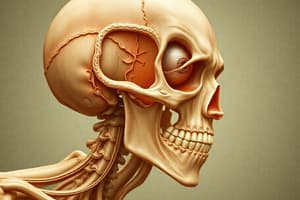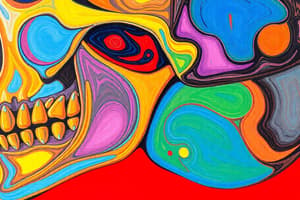Podcast
Questions and Answers
What is the primitive stomatodeum?
What is the primitive stomatodeum?
- A small bump on the developing face
- A deep narrow depression in the developing face
- A group of cells that will form the heart
- A wide, shallow depression in the developing face (correct)
What separates the stomatodeum from the developing heart?
What separates the stomatodeum from the developing heart?
- Branchial clefts
- Pharyngeal pouches
- Branchial arches (correct)
- The buccopharyngeal membrane
How many branchial arches are there?
How many branchial arches are there?
- 4
- There are 5 arches, but one of them disappears.
- 6 (correct)
- 5
What is the basic structure of each branchial arch?
What is the basic structure of each branchial arch?
What is the significance of the first pharyngeal arch?
What is the significance of the first pharyngeal arch?
What derives from the maxillary process of the first pharyngeal arch?
What derives from the maxillary process of the first pharyngeal arch?
Which cartilage is derived from the first pharyngeal arch?
Which cartilage is derived from the first pharyngeal arch?
Which muscle is derived from the second pharyngeal arch?
Which muscle is derived from the second pharyngeal arch?
What is the primary location of the mesoderm at the end of gastrulation?
What is the primary location of the mesoderm at the end of gastrulation?
Which nerve is associated with the first pharyngeal arch?
Which nerve is associated with the first pharyngeal arch?
Which of the following tissues is derived from the endoderm germ layer?
Which of the following tissues is derived from the endoderm germ layer?
What is the typical age range for surgically correcting a cleft palate?
What is the typical age range for surgically correcting a cleft palate?
Which pharyngeal arch is associated with the constrictors of pharynx?
Which pharyngeal arch is associated with the constrictors of pharynx?
What is the correct sequence of germ layers from outermost to innermost at the end of gastrulation?
What is the correct sequence of germ layers from outermost to innermost at the end of gastrulation?
What is a characteristic feature of Mandibulofacial dystostosis (Treacher-Collins syndrome)?
What is a characteristic feature of Mandibulofacial dystostosis (Treacher-Collins syndrome)?
Which of the following tissues is NOT derived from the mesoderm germ layer?
Which of the following tissues is NOT derived from the mesoderm germ layer?
Which cartilage is derived from the third pharyngeal arch?
Which cartilage is derived from the third pharyngeal arch?
What is often associated with cleft palate?
What is often associated with cleft palate?
Which pharyngeal arch is associated with the intrinsic muscles of the larynx?
Which pharyngeal arch is associated with the intrinsic muscles of the larynx?
What is a common feature of Acro-facial dysostosis?
What is a common feature of Acro-facial dysostosis?
How many germ layers are present in the embryo at the end of gastrulation?
How many germ layers are present in the embryo at the end of gastrulation?
What is Hemifacial microsomia characterized by?
What is Hemifacial microsomia characterized by?
What may be associated with Nager syndrome?
What may be associated with Nager syndrome?
Which of the following cranial nerves innervates the sensory receptors in the 1st arch of the tongue?
Which of the following cranial nerves innervates the sensory receptors in the 1st arch of the tongue?
At which week of development does the distal tip of the tongue form?
At which week of development does the distal tip of the tongue form?
Which of the following muscles is derived from the head mesoderm and innervated by the vagus nerve X?
Which of the following muscles is derived from the head mesoderm and innervated by the vagus nerve X?
What is the term for the congenital anomaly where the tongue is tied to the floor of the mouth?
What is the term for the congenital anomaly where the tongue is tied to the floor of the mouth?
Which of the following structures is formed from the median tongue bud?
Which of the following structures is formed from the median tongue bud?
Flashcards
Primitive Stomatodeum
Primitive Stomatodeum
A wide, shallow depression in the developing face.
Separation between stomatodeum and developing heart:
Separation between stomatodeum and developing heart:
Branchial arches.
Number of Branchial Arches
Number of Branchial Arches
6
Basic Structure of Branchial Arch
Basic Structure of Branchial Arch
Signup and view all the flashcards
Significance of 1st Pharyngeal Arch
Significance of 1st Pharyngeal Arch
Signup and view all the flashcards
Derivatives of Maxillary Process
Derivatives of Maxillary Process
Signup and view all the flashcards
Cartilage from 1st Pharyngeal Arch
Cartilage from 1st Pharyngeal Arch
Signup and view all the flashcards
Muscle from 2nd Pharyngeal Arch
Muscle from 2nd Pharyngeal Arch
Signup and view all the flashcards
Primary Location of Mesoderm
Primary Location of Mesoderm
Signup and view all the flashcards
Nerve Associated with 1st Arch
Nerve Associated with 1st Arch
Signup and view all the flashcards
Tissue Derived from Endoderm
Tissue Derived from Endoderm
Signup and view all the flashcards
Age for Cleft Palate Correction
Age for Cleft Palate Correction
Signup and view all the flashcards
Arch for Pharynx Constrictors
Arch for Pharynx Constrictors
Signup and view all the flashcards
Germ Layer Sequence
Germ Layer Sequence
Signup and view all the flashcards
Feature of Mandibulofacial Dystostosis
Feature of Mandibulofacial Dystostosis
Signup and view all the flashcards
Not Mesoderm Derived
Not Mesoderm Derived
Signup and view all the flashcards
Cartilage from 3rd Arch
Cartilage from 3rd Arch
Signup and view all the flashcards
Associated with Cleft Palate
Associated with Cleft Palate
Signup and view all the flashcards
Arch for Larynx Muscles
Arch for Larynx Muscles
Signup and view all the flashcards
Feature of Acro-facial Dysostosis
Feature of Acro-facial Dysostosis
Signup and view all the flashcards
Germ Layers at Gastrulation End
Germ Layers at Gastrulation End
Signup and view all the flashcards
Hemifacial Microsomia
Hemifacial Microsomia
Signup and view all the flashcards
Associated with Nager Syndrome
Associated with Nager Syndrome
Signup and view all the flashcards
Nerve for 1st Arch Tongue
Nerve for 1st Arch Tongue
Signup and view all the flashcards
Tongue Tip Formation
Tongue Tip Formation
Signup and view all the flashcards
Head Mesoderm Muscle
Head Mesoderm Muscle
Signup and view all the flashcards
Tongue Tied Condition
Tongue Tied Condition
Signup and view all the flashcards
Structure Formed From Median Tongue Bud
Structure Formed From Median Tongue Bud
Signup and view all the flashcards
Study Notes
Pharyngeal Arches and Pouches
- Form in the 4th and 5th weeks of development
- 5 arches (1, 2, 3, 4, and 6) and 5 corresponding pouches
- Each arch consists of a 'bar' of mesenchymal tissue, lined on the outside by ectoderm and inside by endoderm
- Separated from each other by deep clefts on the outside and pouches on the inside
Branchial Arches Structure
- Cartilage, nerve, and artery components
- Ectoderm outside, mesenchyme in the middle, and endoderm inside
- Each arch has its own cranial nerve
First Pharyngeal Arch
- Gives origin to the bones of the two lower thirds of the face
- Divided into maxillary and mandibular processes
- Maxillary process forms the maxilla, premaxilla, zygomatic bone, and squamous part of the temporal bone
- Innervated by cranial nerve V (trigeminal)
Tongue Development
- Multiple origins: foramen cecum, median tongue bud, and posterior tongue buds
- Innervated by multiple nerves: cranial nerve V (trigeminal), facial nerve VII, glossopharyngeal IX, and vagus nerve X
- Muscles from occipital somites (hypoglossal nerve XII) and head mesoderm (vagus nerve X)
Pharyngeal Arch Cartilages
- 1st arch: Meckel's cartilage (mandibular prominence)
- 2nd arch: Reichert's or hyoid cartilage
- 3rd arch: none
- 4th arch: none
- 6th arch: none
Pharyngeal Arch Muscles
- 1st arch: muscles of mastication
- 2nd arch: muscles of facial expression
- 3rd arch: stylopharyngeus
- 4th arch: constrictors of pharynx
- 6th arch: intrinsic muscles of the larynx
Craniofacial Development
- Derived from the three germ layers: ectoderm, mesoderm, and endoderm
- Ectoderm forms epidermis and nervous system
- Mesoderm forms skeleton, muscle, dermis, kidney, gonads, and blood
- Endoderm forms gut, liver, lungs, thyroid, and pancreas
Pharyngeal Arch Defects
- Cleft palate
- Mandibulofacial dystostosis (Treacher-Collins syndrome)
- Acro-facial dysostosis
- Nager Syndrome
- Hemifacial microsomia (oto-mandibular syndrome)
Studying That Suits You
Use AI to generate personalized quizzes and flashcards to suit your learning preferences.




